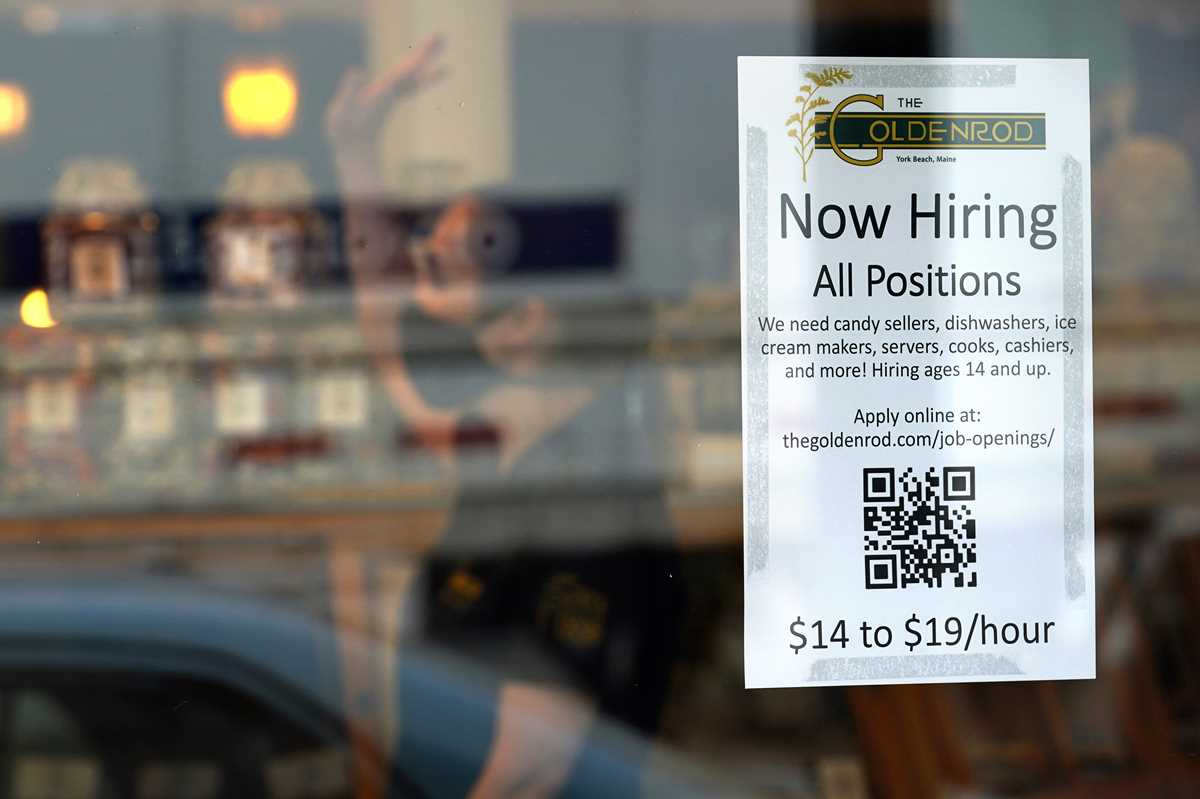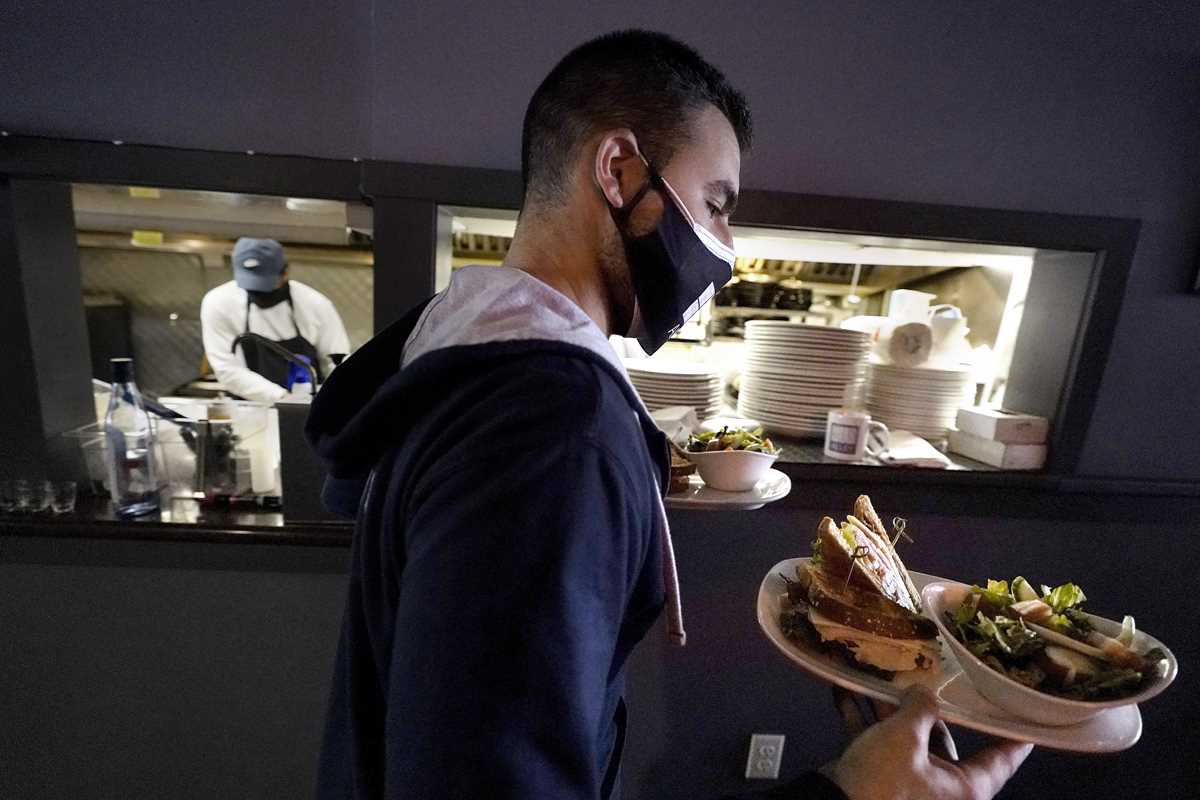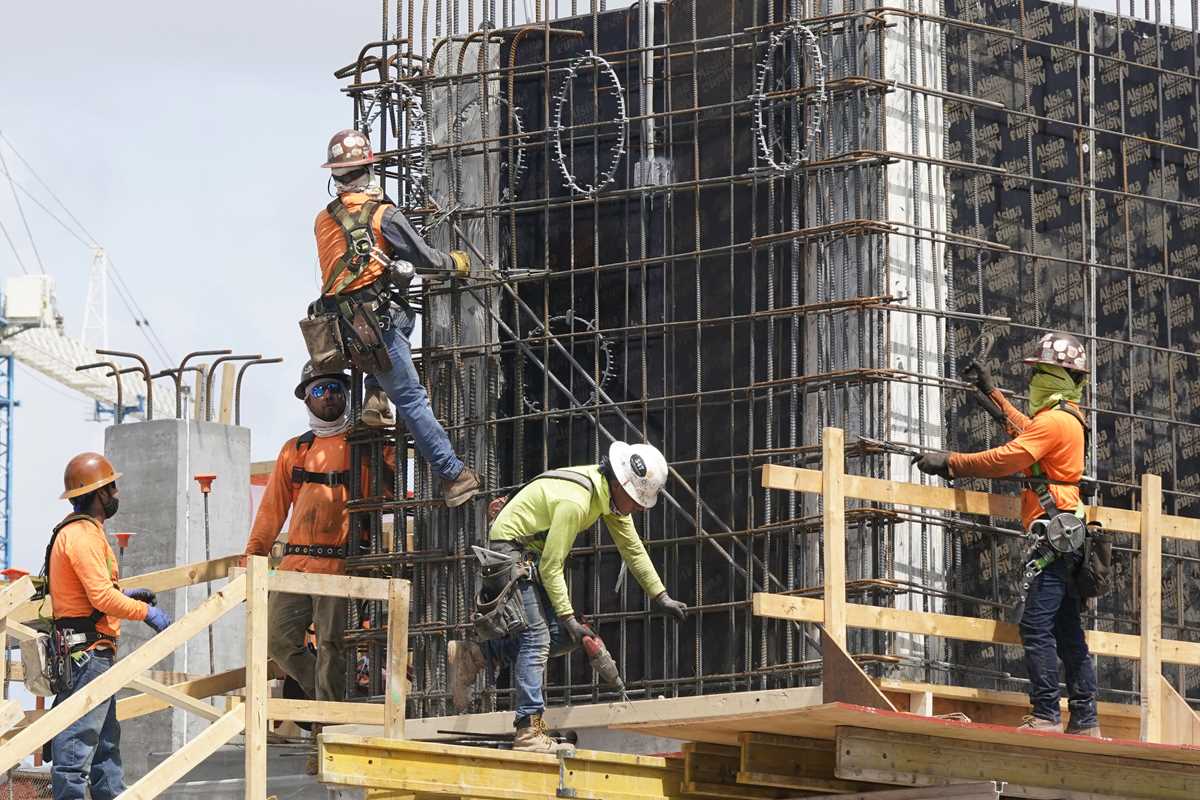 A sign advertises for help The Goldenrod, a popular restaurant and candy shop, Wednesday, June 1, 2022, in York Beach, Maine. The number of available jobs in the U.S. plummeted in August 2022 compared with July as businesses grow less desperate for workers, a trend that could cool chronically high inflation. (AP Photo/Robert F. Bukaty, File)
A sign advertises for help The Goldenrod, a popular restaurant and candy shop, Wednesday, June 1, 2022, in York Beach, Maine. The number of available jobs in the U.S. plummeted in August 2022 compared with July as businesses grow less desperate for workers, a trend that could cool chronically high inflation. (AP Photo/Robert F. Bukaty, File) Bartender Denis Angelov carries plates of food from the kitchen, behind, at Tin Pan Alley restaurant, Tuesday, April 6, 2021, in Provincetown, Mass. The number of available jobs in the U.S. plummeted in August 2022 compared with July as businesses grow less desperate for workers, a trend that could cool chronically high inflation. (AP Photo/Steven Senne, File)
Bartender Denis Angelov carries plates of food from the kitchen, behind, at Tin Pan Alley restaurant, Tuesday, April 6, 2021, in Provincetown, Mass. The number of available jobs in the U.S. plummeted in August 2022 compared with July as businesses grow less desperate for workers, a trend that could cool chronically high inflation. (AP Photo/Steven Senne, File) Construction workers fasten the frame of a new building, Monday, May 3, 2021, in Miami. The number of available jobs in the U.S. plummeted in August 2022 compared with July as businesses grow less desperate for workers, a trend that could cool chronically high inflation. (AP Photo/Marta Lavandier, File)
Construction workers fasten the frame of a new building, Monday, May 3, 2021, in Miami. The number of available jobs in the U.S. plummeted in August 2022 compared with July as businesses grow less desperate for workers, a trend that could cool chronically high inflation. (AP Photo/Marta Lavandier, File)WASHINGTON (AP) — America’s employers slowed their hiring in September but still added 263,000 jobs, a solid figure that will likely keep the Federal Reserve on pace to keep raising interest rates aggressively to fight persistently high inflation.
Friday’s government report showed that hiring fell from 315,000 in August, marking the weakest gain since April 2021. The unemployment rate fell from 3.7% to 3.5%, matching a half-century low.
The Fed is hoping that slower job growth would mean less pressure on employers to raise pay and pass those costs on to their customers through price increases — a recipe for high inflation. But September's hiring — slightly stronger than economists had expected — might not have slowed enough to satisfy the central bank's inflation fighters.
In September, hourly wages rose 5% from a year earlier, the slowest year-over-year pace since December but still hotter than the Fed would want. The proportion of Americans who either have a job or are looking for one slipped slightly, a disappointment for those hoping that more people would enter the labor force and help ease worker shortages and upward pressure on wages.
“A moderation in job and wage growth will be welcome developments for Fed officials,’’ Rubeela Farooqi, chief U.S. economist at High Frequency Economics, wrote in a report. Still, she doesn’t expect the softer jobs and wage numbers to keep the Fed from raising its benchmark short-term rate by a sizable three-quarters of a point in November and by a half-point in December.
Last month, restaurants and bars added 60,000 jobs, as did healthcare companies. State and local governments cut 27,000 jobs. Retailers, transportation and warehouse companies reduced employment modestly.
The public anxiety that has arisen over high prices and the prospect of a recession is carrying political consequences as President Joe Biden’s Democratic Party struggles to maintain control of Congress in November’s midterm elections.
In its epic battle to rein in inflation, the Fed has raised its benchmark interest rate five times this year. It is aiming to slow economic growth enough to reduce annual price increases back toward its 2% target.
It has a long way to go. In August, one key measure of year-over-year inflation, the consumer price index, amounted to 8.3%. And for now, consumer spending — the primary driver of the U.S. economy — is showing resilience. In August, consumers spent a bit more than in July, a sign that the economy was holding up despite rising borrowing rates, violent swings in the stock market and inflated prices for food, rent and other essentials.
Fed Chair Jerome Powell has warned bluntly that the inflation fight will “bring some pain,” notably in the form of layoffs and higher unemployment. Some economists remain hopeful that despite the persistent inflation pressures, the Fed will still manage to achieve a so-called soft landing: Slowing growth enough to tame inflation, without going so far as to tip the economy into recession.
It’s a notoriously difficult task. And the Fed is trying to accomplish it at a perilous time. The global economy, weakened by food shortages and surging energy prices resulting from Russia’s war against Ukraine, may be on the brink of recession. Kristalina Georgieva, managing director of the International Monetary Fund, warned Thursday that the IMF is downgrading its estimates for world economic growth by $4 trillion through 2026 and that “things are more likely to get worse before it gets better.’’
Powell and his colleagues on the Fed’s policymaking committee want to see signs that the abundance of available jobs — there’s currently an average of 1.7 openings for every unemployed American — will steadily decline. Some encouraging news came this week, when the Labor Department reported that job openings fell by 1.1 million in August to 10.1 million, the fewest since June 2021.
Nick Bunker, head of economic research at the Indeed Hiring Lab, suggested that among the items on “the soft-landing flight checklist’’ is “a decline in job openings without a spike in the unemployment rate, and that’s what we’ve seen the last few months.”
On the other hand, by any standard of history, openings remain extraordinarily high: In records dating to 2000, they had never topped 10 million in a month until last year.
Economist Daniel Zhao of the jobs website Glassdoor argued that a single-minded focus on the job market might be overdone. Regardless of what happens with jobs and wages, Zhao suggested, the Fed’s policymakers won’t likely let up on their rate-hike campaign until they see proof that they’re actually hitting their target.
“They want to see inflation slowing down,” he said.
Before you make your next trade, you'll want to hear this.
MarketBeat keeps track of Wall Street's top-rated and best performing research analysts and the stocks they recommend to their clients on a daily basis.
Our team has identified the five stocks that top analysts are quietly whispering to their clients to buy now before the broader market catches on... and none of the big name stocks were on the list.
They believe these five stocks are the five best companies for investors to buy now...
See The Five Stocks Here
Wondering where to start (or end) with AI stocks? These 10 simple stocks can help investors build long-term wealth as artificial intelligence continues to grow into the future.
Get This Free Report